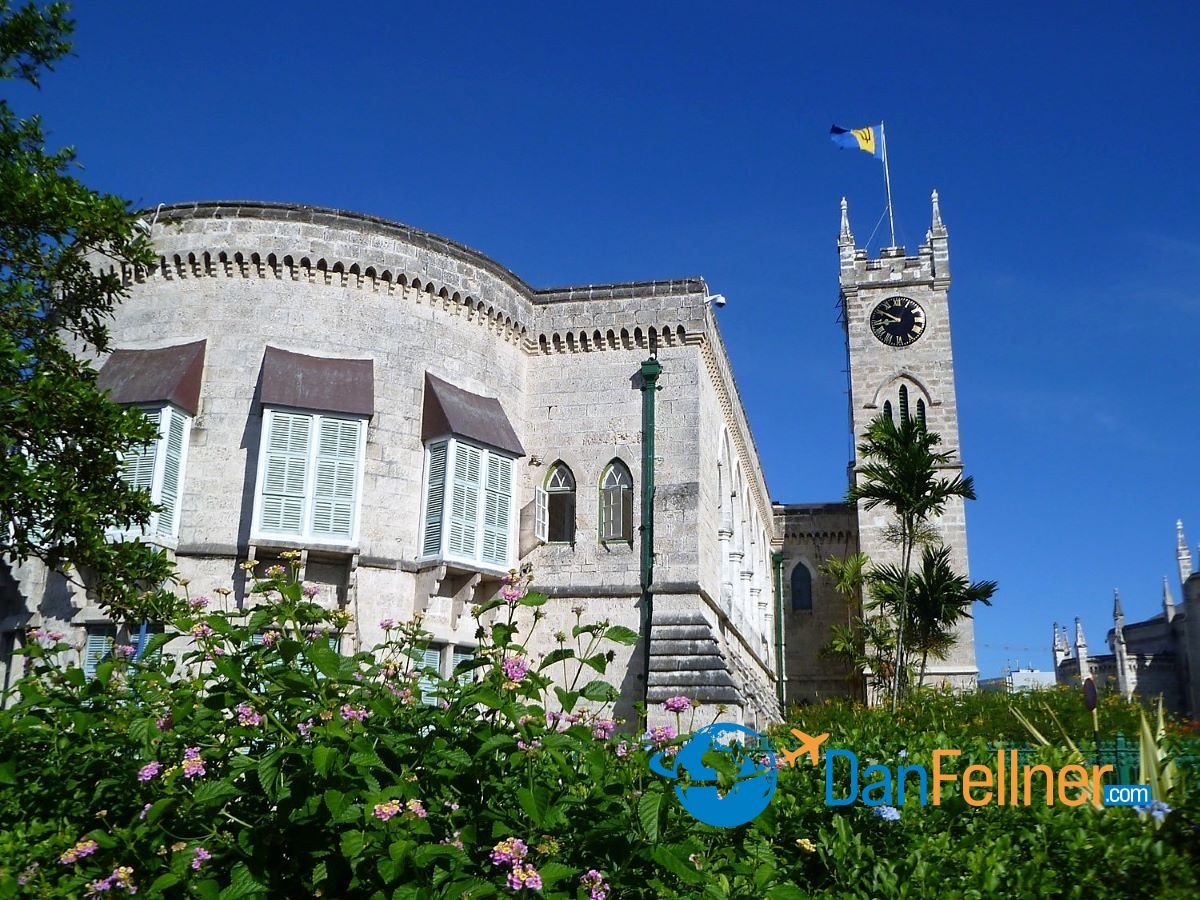Caribbean island home to historically significant Jewish sites
The Jewish News of Greater Phoenix – January 6, 2012
BRIDGETOWN, Barbados – It may be one of the best-kept secrets in the Caribbean.
Barbados, known best for its spectacular white-sand beaches, posh resorts and a rich British colonial heritage, also happens to be home to one of the most historically significant Jewish sites in the Americas.

The sanctuary inside the historic Nidhe Israel Synagogue in Bridgetown, Barbados.
I recently visited Bridgetown, the picturesque capital city of Barbados, during an 11-day southern Caribbean cruise on the Holland America Maasdam. Barbados is the easternmost island in the Caribbean, with a population of about 286,000. It achieved independence from the United Kingdom in 1966.
After a leisurely 30-minute walk from the Maasdam to downtown Bridgetown, I reached a street called Synagogue Lane, turned right and soon found myself in a small courtyard, marveling at several centuries of Jewish history.

The Nidhe Israel synagogue and museum is a 30-minute walk from the Barbados cruise-ship terminal.
In this quiet complex five blocks north of the Barbados Parliament building, visitors can see a reconstructed Sephardic synagogue called Nidhe Israel (“the scattered of Israel”). The original building dates back to 1654, making it the earliest constructed synagogue in the Western Hemisphere still in use today. There is also a Jewish cemetery with more than 300 graves, an interactive museum chronicling the important role Jews played in the island’s history, and a recently discovered 17th-century mikvah, or ritual bath.
I had previously visited historic synagogues on the Caribbean islands of Curacao and St. Thomas, both of which are famous for their sand-covered floors. Those two shuls may be better-known and attract more visitors than their Barbados counterpart, yet Nidhe Israel is the only one of the three dating back to the 17th century. (The Curacao synagogue, consecrated in 1732, has the distinction of being the oldest synagogue in continuous use in the Western Hemisphere.)

Museum Manager Celso Brewster discusses the history of the Barbados Jewish community.
Celso Brewster, who has been the manager of the Nidhe Israel Museum since it first opened in 2008, showed us around the facility. Our port-stop in Barbados happened to fall on a Sunday, and with the museum normally closed on weekends, I was afraid I would not be able to see its exhibits.
But I had contacted Brewster in advance of our visit, and he was kind enough to open up the museum and synagogue for me and several other passengers on the Maasdam, including a rabbi whom Holland America brought onboard to lead Shabbat and Hanukkah services during the cruise. (Contact Brewster by email at nidhe@caribsurf.com and he will gladly arrange weekend viewings.)

The restored Jewish cemetery next to Nidhe Israel synagogue.
Inside the museum, we learned that Jews first arrived on Barbados in 1628, driven from Brazil by the Inquisition. They brought with them expertise in growing sugar cane and in windmill technology. As noted on the exhibit greeting visitors at the museum’s entrance: “For these Jews and their descendants, coconut milk and sugar cane were the milk and honey of the land promised to the people of Abraham.”
With Nidhe Israel as its anchor, the Jewish community in Barbados prospered under British rule. The synagogue was destroyed by a hurricane in 1831 and later rebuilt. But the number of Jews living on the island slowly dwindled over the years due to emigration and assimilation. It is believed that the last of the Sephardic descendants of the Brazilian Jews left the island in 1929. The synagogue fell into disrepair and was sold.

One of the gravestones at the Jewish cemetery dates back to 1658.
The community was slowly re-established in the 1930s by Ashkenazic Jews from Eastern Europe who built another synagogue, Shaare Tzedek, in a residential neighborhood. However, Nidhe Israel remained neglected and unused as a house of worship. The Barbadian government announced plans to demolish it in 1980 to make way for a new Supreme Court building.
But Paul Altman, a prominent Jewish businessman whose grandfather was buried in the cemetery adjacent to Nidhe Israel, pleaded with the prime minister of Barbados to save the historic building.
“He went to the prime minister armed with photographs taken in the 1800s of the inside of the synagogue,” said Brewster. “And the prime minister then relented and told him that if you can raise the funds to save the synagogue, the government will return the synagogue to Jewish hands.”

The parliament building in downtown Bridgetown. The government of Barbados agreed to return Nidhe Israel to Jewish hands.
Altman launched an international fundraising campaign and was able to raise more than $1 million to restore the synagogue. After being dormant for nearly 60 years, Nidhe Israel was rededicated in 1987. The two-story pink building, with beautiful Gothic arches, features stunning chandeliers, and an ark and bimah crafted with Barbadian mahogany. The building is now owned by the Barbados National Trust.
From December through March, the synagogue hosts Friday night services for the island’s nearly 100 year-round Jewish residents, not to mention the scores of Jewish tourists who flock to Barbados during the winter months. Members of the congregation conduct the services, as there is no rabbi. Shaare Tzedek, which is air-conditioned and has a kitchen, is used for services during the rest of the year.

The recently discovered 17th century full-immersion mikvah at Nidhe Israel synagogue in Barbados.
The Jewish cemetery, which has a gravestone dating all the way back to 1658, was also restored. And in 2008, a 260-year-old building in the same complex – originally a Jewish school – reopened as the Nidhe Israel Museum. Its main hall includes several interactive exhibits as well as a floor with glass panels covering sand embedded with artifacts from the cemetery.
The final attraction was discovered in 2008 when archaeologists were digging in the site’s parking lot looking for what had been the rabbi’s house. Instead, they unearthed an ancient full-immersion mikvah, believed to have been built even before the synagogue. But at first, they weren’t sure what it was.
“We thought maybe it was a flooded storeroom filled with ancient rainwater,” said Brewster. “Then one day, two Israeli tourists came, looked over the top, and said, ‘Oh, you have a mikvah.’ That is how we knew for sure.”

The colorful waterfront in downtown Bridgetown, Barbados.
Brewster said the museum averages only about seven visitors per day, a number he believes will steadily grow as word spreads of the historical treasures awaiting Jewish tourists to Barbados. He especially hopes to attract a larger share of the nearly 500,000 passengers who arrive each year at Bridgetown’s cruise terminal.
“This has been called the greatest secret in Bridgetown,” he said. “Even Barbadians don’t know we exist.
“It is a very, very historical site, not only for Barbados, but for the Jews who fled the Inquisition, both in Europe and South America. It represents a new beginning, and so therefore, everyone should know about it. Everyone should see it.”

© 2012 Dan Fellner



